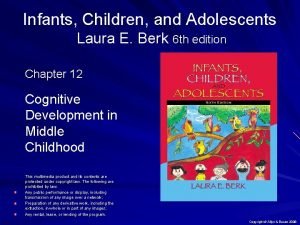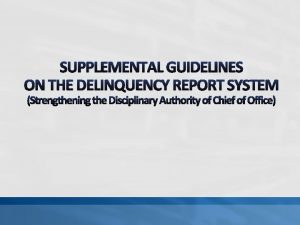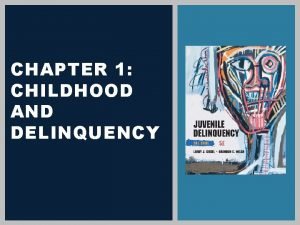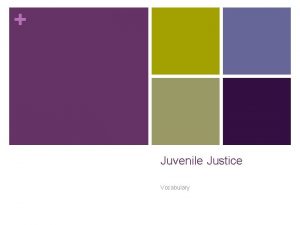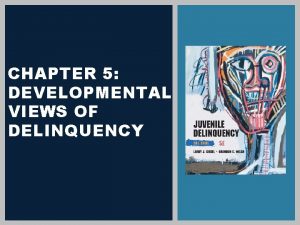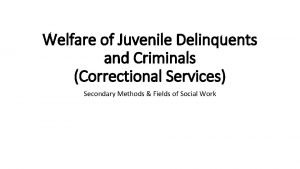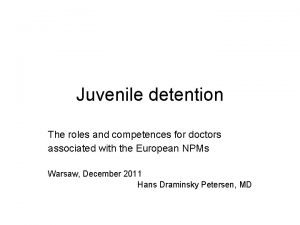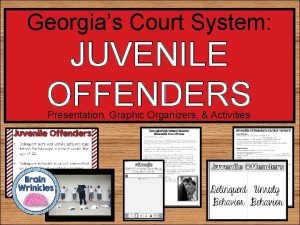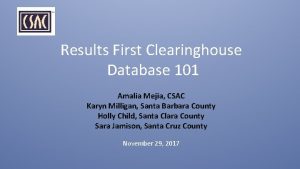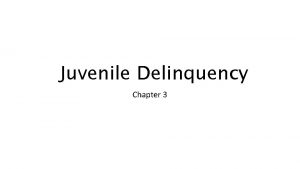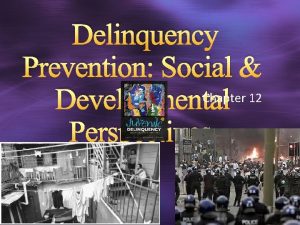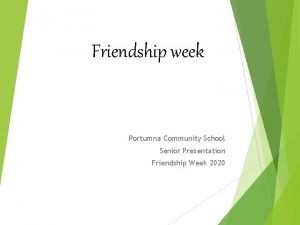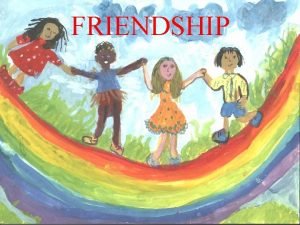FRIENDSHIP AND DELINQUENCY OF ADOLESCENTS First results of




















- Slides: 20

FRIENDSHIP AND DELINQUENCY OF ADOLESCENTS First results of a four wave study on adolescent’s behavior and relations using an actor-driven statistical model Sunbelt conference, Slovenia, May 2004 Andrea Knecht: a. b. knecht@fss. uu. nl Chris Baerveldt: c. baerveldt@fss. uu. nl University of Utrecht; Heidelberglaan 2; 3584 CS Utrecht; The Netherlands Research programme: http: //ppswmm. ppsw. rug. nl/~steglich/dynamics/ Funded by the Netherlands Organization for Scientific Research (NWO)

Overview · Introduction · Theoretical framework · Data · Model description · Results · Further research


Selection

Influence

Introduction Friends are more likely to behave similarly regarding delinquent behavior (e. g. , Haynie 2002). How can similarity in delinquent behavior of adolescent friends be explained: Do similar pupils select each other? or Do pupils influence each other? Problems of earlier research: – Only one mechanism is investigated (selection or influence) Other problems: – Cross-sectional data – Peer reporting – Network studies are rare

Theoretical framework Actor-driven model – Rational choice framework – Implemented in the statistical model SIENA Basic assumptions: – Control of outgoing ties and degree of delinquent behavior – Choice of behavior: cost-benefit analysis – Striving for social approval: status and behavioral confirmation – Relations to those who behave similarly are rewarding

Hypotheses • Selection DELINQUENT BEHAVIOR + FRIENDSHIP RELATION + DELINQUENT BEHAVIOR • Influence FRIENDSHIP RELATION Note: Selection and influence can operate simultaneously. Our study allows to disentangle both processes.

Data: Sample - Pupils in first class of Dutch secondary school (Age: 12 -13 years) - 14 schools with 126 classes (3, 108 pupils) - Different classes - Educational level Denominations Regions (urban and rural areas) Size of school and classes - 4 waves within one school year - High response (> 93%)

Data: Measurements • Network question: Who are your best friends in class? Up to 12 nominations • Behavior question: – Stealing – Breaking something – Graffiti – Fighting – Buying illegal copies of a music CD or a PC game 5 answer categories => Delinquency scale (5 -25)

Importance of friends in class August / September November/ December Most friends in class 43. 7% 51. 3% Most important friends in class 54. 2% 55. 1% Number of best friends in class 3. 55 4. 17

Delinquent behavior (in %) Steal Break sth. Fight Graffiti Having or buying an illegal copy Delinquency Scale Aug. /Sept. Nov. / Dec. boys girls 8. 9 15. 5 39. 3 10. 1 57. 0 5. 1 11. 2 20. 4 7. 4 39. 6 16. 2 24. 5 51. 3 20. 2 65. 8 9. 8 16. 2 26. 6 16. 0 50. 0 7. 65 6. 42 8. 72 7. 14

Network model Friendship relations as dependent variable Expected effects: X Delinquent behavior (sim. ) Y: Friendship relation + Controlling for: Density - Reciprocity + Actors at distance 2 - Popularity + Friends at primary school + Gender (similarity) +

Behavior model Delinquent behavior as dependent variable Expected effects: X Y: Delinquent behavior of friends (Similarity) + Delinquent behavior x popularity of friend + Gender (girl 1; boy 2) +

Results: Example for behavior and network effects in one SIENA model for one network and three waves Estimate Standard error EFFECT ON NETWORK Rate (period I) 9. 25 2. 17 Rate (period II) 3. 64 0. 69 Delinquent behavior similarity 0. 07 0. 40 -1. 42 0. 33 1. 30 0. 23 -0. 82 0. 15 Friends at primary school 0. 41 0. 23 Gender (similarity) 0. 31 0. 22 Rate (period I) 18. 92 16. 37 Rate (period II) 9. 87 7. 16 Delinquent behavior similarity 1. 09 3. 26 -0. 30 1. 32 Density Reciprocity Actors at distance 2 EFFECT ON BEHAVIOR Similarity x popularity alter

Network model: Results of meta analysis (SIENA parameters for 20 networks) Mean Rate 8. 222 Density -1. 823 Reciprocity 1. 402 Distance 2 -0. 925 Primary school 0. 574 Gender 0. 688 Delinquency 0. 122 S. E. 0. 609 0. 127 0. 098 0. 053 0. 121 0. 098 0. 014 Variance S. E. of Variance 3. 596 0 0. 051 0. 006 0. 086 0 0 2. 170 0 0. 057 0. 015 0. 084 0 0

Further research Extension of the analysis • More networks • Four measuring points • Behavior as dependent variable • Considering the difference between creating and breaking a tie • Meta analysis with ‘complete’ model (network and behavioral effects)

References Haynie, D. L. (2002). "Friendship networks and delinquency: the relative nature of peer delinquency. " Journal of Quantitative Criminology 18: 99 -134. Snijders, T. (2001). The statistical evaluation of social network dynamics. Sociological Methodology. S. M. and B. M. Boston and London, Basil Blackwell: 361 -395. Snijders, T. and C. Baerveldt (2003). "A Multilevel Network Study of the Effects of Delinquent Behavior on Friendship Evolution. " Journal of Mathematical Sociology 27: 123151.

Selected questions from the pupil’s questionnaire I Network questions • A maximum of 12 nominations is possible • Measured only once: With whom from your classmates have you been friends at primary school? • Measured at four time points: Who from your classmates helps you with practical problems such as homework? Who from your classmates helps you when you are at a loss? With whom do you talk about personal things such as problems at home? Who are your best friends at class? With whom from your class would you like to be friends? Who in your class do you not like? With whom from your class do you arrange to meet outside school? Who in your class did bully you? Who in your class listens to the same music? Who in your class likes the same clothes? Whom in your class would you lend Euro 25? Whom in your class would you never lend Euro 25? Whose opinion from someone in your class is important to you? With whom from your class do you compare grades?

Selected questions from the pupil’s questionnaire II Behavior questions Answer categories: Never, once, 2 to 4 times, 5 to 10 times, more than 10 times What have you done in the last three months? (Asked at four measuring points) Delinquent behavior: stealing, fighting, graffiti, having or buying illegal copies of PC game or CD, breaking something School behavior: being late, skipping class… Life style & others: smoking, drinking Background information For example: Socio-economic status of parents Religion Ethnicity In addition to the four pupil’s questionnaire, we also have four questionnaires for the class teachers. Questionnaire (in Dutch) available on request
 Infants children and adolescents 8th edition
Infants children and adolescents 8th edition Lara berk
Lara berk What is the difference between courting and dating
What is the difference between courting and dating Nature of juvenile delinquency
Nature of juvenile delinquency D&b delinquency predictor score
D&b delinquency predictor score Poverty and delinquency
Poverty and delinquency Pnp delinquency report form
Pnp delinquency report form Delinquency management meaning
Delinquency management meaning According to choice theorists, offenders:
According to choice theorists, offenders: Objectives of studying juvenile delinquency
Objectives of studying juvenile delinquency Juvenile justice vocabulary
Juvenile justice vocabulary Juvenile delinquents turn heroes
Juvenile delinquents turn heroes Female delinquency theories
Female delinquency theories Developmental theory juvenile delinquency
Developmental theory juvenile delinquency Delinquency predictor score
Delinquency predictor score Categories of delinquent youth
Categories of delinquent youth Management of juvenile delinquency
Management of juvenile delinquency Delinquency management system
Delinquency management system Management of juvenile delinquency
Management of juvenile delinquency Juvenile delinquency graphic organizer
Juvenile delinquency graphic organizer Results first clearinghouse database
Results first clearinghouse database

